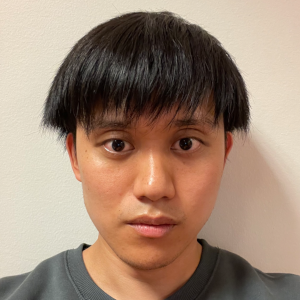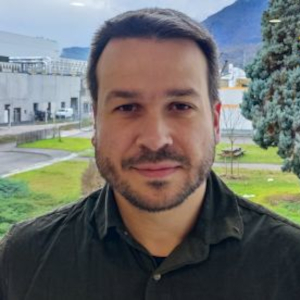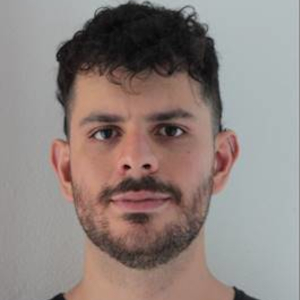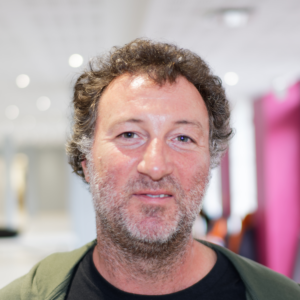Overview
Our team aims at manipulating spins currents in nanostructures, in particular in quantum materials with Dirac fermions, such as topological insulators or Weyl semimetals, or at oxide interfaces. Some important aspects of future spintronics devices, such as the efficient spin-charge interconversion at interfaces or the ballistic transport of spin states for quantum interconnects, are studied by magneto-transport measurements.
Research topics
Spin-Charge interconversion
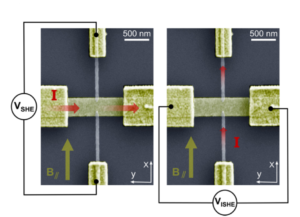
Nanostructure made of a horizontal stripe of spin Hall effect material, with two vertical ferromagnetic electrodes to probe the spin accumulation or to inject spin currents. The nanostructure allows probing both the charge-to-spin (left) and spin-to-charge (right) conversions due to the spin-orbit coupling.
Control of magnetization
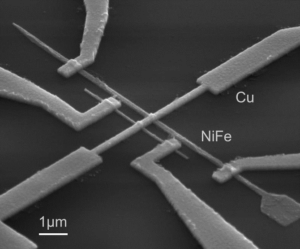
Nanostructure possessing NiFe nanowires, in which magnetic domain walls can propagate. When located at the vicinity of the Cu nanowire, the domain wall can be used to inject or detect pure spin currents.
Ballistic spin currents

The ballistic surface Dirac fermions in a 3D topological insulator propagate on the cristal faces of a quantum wire. The well-defined cross section gives flux-periodic Aharonov-Bohm oscillations of the resistance, due to quantum interference, for a magnetic induction applied parallel to the nanowire. The spin-helical surface modes offer new possibilities to build quantum spintronics devices of simple geometry, either for dissipationless long-range interconnects or local spin filtering controled by a magnetic field or an electrostatic gate.
The team
Former members
Post-docs
- Yu FU (2015-2016)
- Juan Carlos ROJAS SANCHEZ (2010-2013)
- Yu FU (2015-2016, 2018-2019)
PhDs
- Andrei Mihai (2006-2009)
- Van Dai Nguyen (2009-2012)
- Piotr Laczkowski (2009-2012)
- Williams Savero-Torres (2011-2014)
- Pham Van Tuong (2014–2017)
- Gilles Zhand (2014-2017)
- Toshiki Gushi (2016-2019)
- Paul Noël (2016-2019)
- Aoyu Tan (2018-2021)
- Valentin Labracherie (2017-2021)
- Maxen Cosset-Cheneau (2019-2022)
- Sambit Ghosh (2019-2022)
Internships
- Williams Savero-Torres (2011)
- Gilles Zahnd (2014)
- Paul Noël (2016)
- Maxen Cosset-Cheneau (2018)
- Timothé Faivre (2009)
- Hélène Durand (2005)
- Andrei Mihai (2006)
- Carl Naylor (2011)
- Quentin Thiburce (2013)
- Clément Nguyen (2013)
- Sarah Ferry (2009)
- Cédric Mannequin (2008)
- Quentin Riffard (2010)
- Willy Lim (2016)
- Matthieu Praquin (2018)
- Marie-Paule Okinda (2020)
Visitors
- Sara Varotto (2019-2020)
Projects
- ANR Contrabass (2020-2023)
- ITN H2020 Spears (2021-2024)
- ANR Oiso (2017-2021)
- ISP Idex UGA DOMINO (2018-2021)
- FET Proactive H2020 Tocha (2019-2023)
- IRS Idex UGA (2017-2020)
Partners
- Tsukuba University (Japan)
- Unité mixte de Physique CNRS/Thalès (Orsay)
- Néel Institute (Grenoble)
- Leti (Grenoble)
- Institut Jean Lamour (Nancy)
- Leibniz Institute IFW (Dresden)
- Technical University (Dresden)
Recent news
- Electrical detection of magnetic domain walls by inverse and direct spin Hall effect (August 28th, 2017)

Spin orbit torques allow to move efficiently DW in tracks made of ferromagnetic/spin Hall effect bilayer. Domain wall (DW) detection is then of great importance. In this letter, we demonstrate a detection method, based on ... - Evidence for spin to charge conversion in GeTe(111), among most read 2016 papers of APL Mater. (August 28th, 2017)

GeTe has been predicted to be the father compound of a new class of multifunctional materials: ferroelectric Rashba semiconductors. In that sense, they are expected to display a coupling between spin-dependent k-splitting and ferroelectricity, thus allowing ... - OISO – An ANR project (August 23rd, 2017)

The ANR project OISO (OxIde-based SpinOrbitronics) explores the potential of transition metal oxide (TMO) perovskites for SpinOrbitronics. SpinOrbitronics exploits the spin-orbit coupling (SOC) to obtain spin currents without ferromagnets (FM), more efficient torques to switch ... - PhD defense : Ferromagnetic/nonmagnetic nanostructures for the electrical measurement of the spin Hall effect and the detection of domain walls (April 27th, 2017)

On Friday, the 12th Of May 2017 at 10h00, Van Tuong PHAM from UGA (DRF/INAC/SPINTEC), will defend his PhD thesis entitled “Ferromagnetic/nonmagnetic nanostructures for the electrical measurement of the spin Hall effect and the detection ... - Giant and tunable spin-charge conversion at oxide interfaces (April 14th, 2017)

At the interface between the strontium titanate and the lanthanide aluminate forms a 2 dimensional electron system. By using a dynamical spin injection technique, we were able to demonstrate a record conversion yield between spin ...







